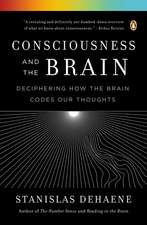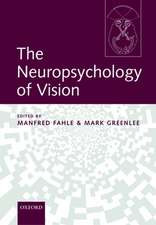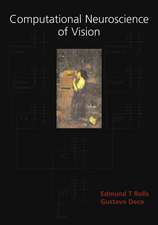Characterizing Consciousness: From Cognition to the Clinic?: Research and Perspectives in Neurosciences
Editat de Stanislas Dehaene, Yves Christenen Limba Engleză Hardback – 14 iun 2011
| Toate formatele și edițiile | Preț | Express |
|---|---|---|
| Paperback (1) | 940.72 lei 43-57 zile | |
| Springer Berlin, Heidelberg – 23 aug 2016 | 940.72 lei 43-57 zile | |
| Hardback (1) | 944.99 lei 22-36 zile | |
| Springer Berlin, Heidelberg – 14 iun 2011 | 944.99 lei 22-36 zile |
Din seria Research and Perspectives in Neurosciences
- 18%
 Preț: 938.83 lei
Preț: 938.83 lei - 18%
 Preț: 941.68 lei
Preț: 941.68 lei - 18%
 Preț: 1218.21 lei
Preț: 1218.21 lei - 18%
 Preț: 945.92 lei
Preț: 945.92 lei - 5%
 Preț: 1409.69 lei
Preț: 1409.69 lei - 18%
 Preț: 1215.70 lei
Preț: 1215.70 lei - 5%
 Preț: 711.72 lei
Preț: 711.72 lei - 18%
 Preț: 944.36 lei
Preț: 944.36 lei - 18%
 Preț: 936.95 lei
Preț: 936.95 lei - 18%
 Preț: 944.19 lei
Preț: 944.19 lei - 15%
 Preț: 638.89 lei
Preț: 638.89 lei - 18%
 Preț: 945.62 lei
Preț: 945.62 lei - 15%
 Preț: 636.63 lei
Preț: 636.63 lei - 15%
 Preț: 636.63 lei
Preț: 636.63 lei - 18%
 Preț: 886.62 lei
Preț: 886.62 lei - 15%
 Preț: 635.47 lei
Preț: 635.47 lei - 15%
 Preț: 636.30 lei
Preț: 636.30 lei - 15%
 Preț: 635.65 lei
Preț: 635.65 lei - 15%
 Preț: 636.12 lei
Preț: 636.12 lei - 24%
 Preț: 734.67 lei
Preț: 734.67 lei -
 Preț: 422.31 lei
Preț: 422.31 lei - 5%
 Preț: 517.17 lei
Preț: 517.17 lei - 18%
 Preț: 937.41 lei
Preț: 937.41 lei
Preț: 944.99 lei
Preț vechi: 1152.43 lei
-18% Nou
Puncte Express: 1417
Preț estimativ în valută:
180.83€ • 189.27$ • 150.50£
180.83€ • 189.27$ • 150.50£
Carte disponibilă
Livrare economică 10-24 martie
Preluare comenzi: 021 569.72.76
Specificații
ISBN-13: 9783642180149
ISBN-10: 3642180140
Pagini: 210
Ilustrații: XII, 202 p. 31 illus., 20 illus. in color.
Dimensiuni: 155 x 235 x 17 mm
Greutate: 0.43 kg
Ediția:2011
Editura: Springer Berlin, Heidelberg
Colecția Springer
Seria Research and Perspectives in Neurosciences
Locul publicării:Berlin, Heidelberg, Germany
ISBN-10: 3642180140
Pagini: 210
Ilustrații: XII, 202 p. 31 illus., 20 illus. in color.
Dimensiuni: 155 x 235 x 17 mm
Greutate: 0.43 kg
Ediția:2011
Editura: Springer Berlin, Heidelberg
Colecția Springer
Seria Research and Perspectives in Neurosciences
Locul publicării:Berlin, Heidelberg, Germany
Public țintă
ResearchCuprins
Preface.- Missing Links in the Evolution of Language.- Consciousness as a Decision to Engage.- Thinking about Brain and Consciousness.- The Global Neuronal Workspace Model of Conscious Access: From Neuronal Architectures to Clinical Applications.- Disorders of Consciousness; What Do We Know?- When Thoughts Become Actions: Imaging Disorders of Consciousness.- Rhythmic Neuronal Synchronization Subserves Selective Attentional Processing.- Studying Consciousness Using Direct Recording from Single Neurons in Humans.- Intrinsic Activity and Consciousness.- Beyond Libet: Long-term Prediction of Free Choices from Neuroimaging Signals.- Subliminal Motivation of the Human Brain.- From Conscious Motor Intention to Movement Awareness.- Subject Index.
Textul de pe ultima copertă
Characterizing the computational architecture and neurobiological mechanisms underlying consciousness is a major unsolved problem in cognitive neuroscience. Yet, thanks to new advances in stimulation paradigms, brain imaging techniques, and neuronal theorizing, the issue now appears to be empirically addressable. In this book thirteen renowned neuroscientists and clinicians examined the most recent data in the field including the possibility to study consciousness in non-human primates. New paradigms now ask whether animals possess meta-cognitive abilities, such as a self-monitoring of their competence in a task, and electrophysiologists now examine the underlying neuronal networks. Many of these results appear compatible with the theory of a global neuronal workspace, which proposes that a distributed set of neurons with long-distance axons are involved in the global information broadcasting underlying reportability and what is experienced as a conscious state.
A major challenge still confronts these novel empirical and theoretical proposals: will they be able to help clinicians confronted with patients in coma or vegetative state? Is a given patient conscious? Will he ever recover consciousness? And what will be his cognitive state if he does? Brain stimulation paradigms, whether cortical or in deep-brain nuclei, can alter the state of consciousness and may improve communication in some 'minimally conscious' patients.
A major challenge still confronts these novel empirical and theoretical proposals: will they be able to help clinicians confronted with patients in coma or vegetative state? Is a given patient conscious? Will he ever recover consciousness? And what will be his cognitive state if he does? Brain stimulation paradigms, whether cortical or in deep-brain nuclei, can alter the state of consciousness and may improve communication in some 'minimally conscious' patients.
Caracteristici
Fifteen of the foremost scientists in this field presented testable theoretical models of consciousness and discussed how our understanding of the role that consciousness plays in our cognitive processes is being refined with some surprising results. At last being able to look into the human mind at work is both very exciting and somewhat daunting. As well as providing a window into the current state of this field, the meeting was likely to stimulate a lively debate about some of the issues and implications raised by this work. Includes supplementary material: sn.pub/extras
















